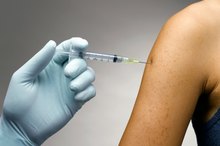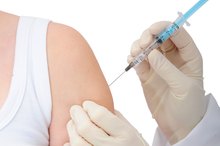Side Effects of Discontinuing Use of a NuvaRing
The NuvaRing is a small flexible plastic ring inserted into the vagina to prevent pregnancy. According to Planned Parenthood, the hormones in NuvaRing are the same hormones as in the birth control pill, estrogen and progestin 1. These hormones work by inhibiting ovulation, altering the uterine lining and cervical mucous. Women can experience side effects after ending use of the NuvaRing.
If you are experiencing serious medical symptoms, seek emergency treatment immediately.
Menstrual Irregularity
The hormones present in NuvaRing might take some time to decrease in the body, resulting in menstrual irregularity. Women also might notice that their periods are heavier or lighter. These side effects should diminish as the body rids itself of the excess estrogen and progesterone. According to Planned Parenthood, after ring use is stopped, it usually takes one to two months for a woman’s periods to return to the cycle she had before using it 1.
- The hormones present in NuvaRing might take some time to decrease in the body, resulting in menstrual irregularity.
Amenorrhea
Prenatal Vitamins & Depo-Provera
Learn More
Women might experience amenorrhea, or an absence of menstruation after discontinuation of the NuvaRing. This can go on for as long as six months after stopping, and it is more likely to occur if your periods were irregular before using the ring, Planned Parenthood says 1. In some cases, amenorrhea might be a sign of pregnancy. Women who have had intercourse after stopping the ring and do not have a menstrual period might want to take a home pregnancy test.
- Women might experience amenorrhea, or an absence of menstruation after discontinuation of the NuvaRing.
Infertility
It might take some time for a woman's fertility to return after removal of the NuvaRing. According to the manufacturer, results of a clinical study indicate that a return to normal ovulation typically occurs within 13 to 28 days after removing the ring. However, some women might take a longer to begin ovulating. Women should consult their physician if they experience infertility after using the ring. Certain methods—such as monitoring the body's basal body temperature, cervical mucous charting, and ovulation predictor kits—might be helpful at predicting ovulation and increasing the odds of conception.
- It might take some time for a woman's fertility to return after removal of the NuvaRing.
- However, some women might take a longer to begin ovulating.
Related Articles
References
- Planned Parenthood: Birth Control Vaginal Ring
- Product Site: NuvaRing: Common Questions
- Planned Parenthood. Birth control ring.
- NuvaRing. Highlights of prescribing information. Revised May 2019.
- Planned Parenthood. What do I do if I want to get pregnant?
- Planned Parenthood. What are the benefits of NuvaRing?
- NuvaRing. Frequently asked questions.
- Planned Parenthood. How do I get NuvaRing?
- Merck. NuvaRing.
- NuvaRing. How should I use NuvaRing?
- Planned Parenthood. How effective is the birth control ring?
- Roumen FJME, Mishell DR. The Contraceptive Vaginal Ring, NuvaRing, a Decade After Its Introduction. The European Journal of Contraception & Reproductive Health Care. 2012;17(6):415–427. doi:10.3109/13625187.2012.713535.
Writer Bio
Laura Candelaria is a family nurse practitioner and assistant professor of nursing and nutritional science. Her experience includes neonatal and pediatric intensive-care, women's oncology, gynecology, obstetrics, lactation, nutrition and infertility. She has been published in "Nursing Spectrum," "Newsday" and on various websites.








